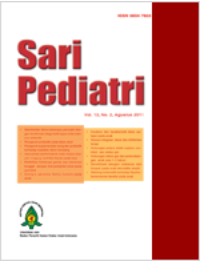Perbandingan Kemampuan Kriteria WHO 1997 dan Klasifikasi DENCO dalam Diagnosis dan Klasifikasi Infeksi Dengue
Sari
Latar belakang. Sejalan dengan kemajuan ilmu pengetahuan, spektrum klinis infeksi dengue semakin luas dan
bervariasi yang diikuti oleh beberapa klasifikasi infeksi dengue baru. Sejauh mana Kriteria WHO-1997 dan
klasifikasi baru ini mampu mendeteksi infeksi dengue pasien di RS Sumber Waras, belum pernah dinilai.
Tujuan. Membandingkan kesesuaian antara hasil konfirmasi laboratorium untuk infeksi dengue dengan
kriteria WHO-1997, Klasifikasi DENCO, dan modifikasi WHO-1997 di RS Sumber Waras. Selain itu
dinilai kemampuan ketiga kriteria/klasifikasi dalam mengelompokkan spektrum klinis infeksi dengue.
Metode. Merupakan penelitian diskriptif retrospektif dengan menggunakan data penelitian kami terdahulu
(cluster study untuk dengue).
Hasil. Dalam periode tahun 2004-2008, terdapat 107 subjek penelitian terdiri 98 kasus infeksi virus dengue
(serologi dan/atau virology positif) dan 9 sakit namun bukan kasus infeksi virus. Data menunjukkan
bahwa dari 98 kasus terbukti infeksi dengue, 96 sesuai dengan Kriteria WHO 1997, 97 sesuai Klasifikasi
Denco, dan 97 sesuai Modifikasi WHO-1997 di RS Sumber Waras. Terdapat 24 subjek yang tidak dapat
diklasifikasikan dengan kriteria WHO 1997 yang ternyata 19 subjek dengue dengan tanda peringatan dan
5 subjek dengue berat berdasarkan Klasifikasi DENCO, sedangkan dengan modifikasi WHO-1997 RSSW
(perdarahan bukan syarat mutlak), didapat 19 subjek DBD, SSD 2 subjek, DBD ensefalopati 1 subjek,
dan SSD ensefalopati 2 subjek.
Kesimpulan. Kriteria WHO-1997 masih merupakan kriteria yang sesuai dalam diagnosis infeksi dengue,
namun untuk dapat mengelompokan spektrum klinis infeksi dengue perlu dipertimbangkan agar manifestasi
perdarahan tidak digunakan sebagai syarat mutlak.
Kata Kunci
Teks Lengkap:
PDFReferensi
Organization WH. Dengue Hemorrhagic Fever: diagnosis,
treatment, prevention and control, . Second edition ed.
Geneva: WHO, 1997.
Lum LC, Lam SK, Choy YS, George R, Harun F.
Dengue encephalitis: a true entity? Am J Trop Med Hyg
;54:256-9.
Soares CN, Cabral-Castro MJ, Peralta JM, Freitas
MR, Puccioni-Sohler M. Meningitis determined by
oligosymptomatic dengue virus type 3 infection: report
of a case. Int J Infect Dis 2010;14:e150-2.
Lum LC, Lam SK, George R, Devi S. Fulminant hepatitis
in dengue infection. Southeast Asian J Trop Med Public Health 1993;24:467-71.
Balmaseda A, Hammond SN, Perez MA, Cuadra R,
Solano S, Rocha J, dkk. Short report: assessment of the
World Health Organization scheme for classification
of dengue severity in Nicaragua. Am J Trop Med Hyg
;73:1059-62.
Khan NA, Azhar EI, El-Fiky S, Madani HH, Abuljadial
MA, Ashshi AM, dkk. Clinical profile and outcome of
hospitalized patients during first outbreak of dengue in
Makkah, Saudi Arabia. Acta Trop 2008;105:39-44.
Phuong CX, Nhan NT, Kneen R, Thuy PT, van Thien
C, Nga NT, dkk. Clinical diagnosis and assessment of
severity of confirmed dengue infections in Vietnamese
children: is the world health organization classification
system helpful? Am J Trop Med Hyg 2004;70:172-9.
Setiati TE, Mairuhu AT, Koraka P, Supriatna M, Mac
Gillavry MR, Brandjes DP, dkk. Dengue disease severity
in Indonesian children: an evaluation of the World
Health Organization classification system. BMC Infect
Dis 2007;7:22.
Deen JL, Harris E, Wills B, Balmaseda A, Hammond
SN, Rocha C, dkk. The WHO dengue classification
and case definitions: time for a reassessment. Lancet
;368:170-3.
Ng CF, Lum LC, Ismail NA, Tan LH, Tan CP. Clinicians’
diagnostic practice of dengue infections. J Clin Virol
;40:202-6.
Kabra SK, Jain Y, Pandey RM, Madhulika, Singhal T,
Tripathi P, dkk. Dengue haemorrhagic fever in children
in the 1996 Delhi epidemic. Trans R Soc Trop Med Hyg
;93:294-8.
Organization WH. Dengue: Guidelines for diagnosis,
treatment, prevention and control. Edisi ke-1. Geneva:
WHO/TDR, 2009.
Charmagneg. Beckett HK, Indrafaisal, Nurhayati,
Ratnatan, Susanawidjaja, dkk. Early Detection of
Dengue Infections Using Cluster Sampling Around
Index Cases Am. J. Trop. Med. Hyg 2005;72:6.
Pervin M, Tabassum S, Islam MN. Isolation and
serotyping of dengue viruses by mosquito inoculation
technique from clinically suspected cases of dengue fever.
Bangladesh Med Res Counc Bull 2002;28:104-11.
Chan SY, Kautner I, Lam SK. Detection and serotyping
of dengue viruses by PCR: a simple, rapid method for
the isolation of viral RNA from infected mosquito larvae.
Southeast Asian J Trop Med Public Health 1994;25:258-
Kuno G, Gomez I, Gubler DJ. An ELISA procedure
for the diagnosis of dengue infections. J Virol Methods
;33:101-13.
Murgue B, Deparis X, Chungue E, Cassar O, Roche
C. Dengue: an evaluation of dengue severity in French
Polynesia based on an analysis of 403 laboratoryconfirmed
cases. Trop Med Int Health 1999;4:765-73.
Bandyopadhyay S, Lum LC, Kroeger A. Classifying
dengue: a review of the difficulties in using the WHO
case classification for dengue haemorrhagic fever. Trop
Med Int Health 2006;11:1238-55.
Gupta P, Khare V, Tripathi S, Nag VL, Kumar R, Khan
MY, dkk. Assessment of world health organization
definition of dengue hemorrhagic fever in North India.
J Infect Dev Ctries 2010;4:150-5.
Talavera D, Castillo AM, Dominguez MC, Gutierrez
AE, Meza I. IL8 release, tight junction and cytoskeleton
dynamic reorganization conducive to permeability
increase are induced by dengue virus infection of
microvascular endothelial monolayers. J Gen Virol
;85:1801-13.
Dewi BE, Takasaki T, Kurane I. In vitro assessment
of human endothelial cell permeability: effects of
inflammatory cytokines and dengue virus infection. J
Virol Methods 2004;121:171-80.
Lei HY, Yeh TM, Liu HS, Lin YS, Chen SH, Liu CC.
Immunopathogenesis of dengue virus infection. J Biomed
Sci 2001;8:377-88.
Martinez RA, Diaz FA, Villar LA. Evaluation of the
world health organization clinical definition of dengue.
Biomedica 2005;25:412-6.
DOI: http://dx.doi.org/10.14238/sp12.5.2011.335-41
Refbacks
- Saat ini tidak ada refbacks.
##submission.copyrightStatement##
##submission.license.cc.by-nc-sa4.footer##
Email: editorial [at] saripediatri.org


Sari Pediatri diterbitkan oleh Badan Penerbit Ikatan Dokter Anak Indonesia
Ciptaan disebarluaskan di bawah Lisensi Creative Commons Atribusi-NonKomersial-BerbagiSerupa 4.0 Internasional.




